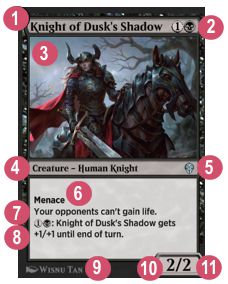The parts of a card on Arena are just a little bit different from a paper card, in part because Arena cards don’t have the footer detail about the card and because Arena cards don’t have the flavor text from the paper cards on the front – it shows up in a small pop-up next to the card when you mouse over it.

This is a card from Arena. The numbered areas are the important parts of the card:
1- The card name. Sometimes cards are reprinted into different sets and/or with different art; as long as the name is a match, it’s functionally the same card.
2- The card’s cost and color. This card costs one generic mana and one black mana to case, so it has a
mana value of 2. Because the colored mana needed to cast it is black, it is a black card. If casting required more than one color of mana, it would be a multicolor card. If it required only generic mana, it would be a colorless card.
3- This is the card art.
4- The type line. To the left of the dash is the card’s supertype; to the right of the dash is the card’s subtype. The most common supertypes in Standard are Artifact, Battle, Creature, Enchantment, Instant, Land, Planeswalker, and Sorcery. Another post will cover these supertypes and each of their subtypes.
5- The expansion symbol. Each card set has a unique symbol that shows what set a card originated in. This card is from Dominaria United. The color of the symbol shows the rarity of that card. From easiest to hardest to find, the colors are black for common, silver for uncommon, gold for rare, and red-orange for mythic rare. This card is an uncommon card. Another post will go into what these rarities mean and how they affect collecting cards and building decks.
6- This area shows a keyword. Keywords are shortcut words that indicate particular common abilities a card can have. This card has Menace – it takes two creatures to block it when it attacks another player. Other posts will go into detail about different keywords and what they mean. Not all cards have keywords.
7- This line tells what static abilities the card has. In this case, as long as this card is on the battlefield under your control, your opponent cannot gain life even if he has cards that would normally increase his life total.
8- This is an ability that has a cost. It indicates that if you pay one generic and one black mana, you can add a +1/+1 counter to this card until the end of the turn.
9- This is the artist who created the art that appears on the card. In a paper card this area would also have a set indicator, a card number, and copyright text in this area.
10- This number is the card’s power. Power is the amount of damage a creature can do when it attacks.
11- This number is the card’s toughness. Toughness is how much damage a card can take before it “dies”.
There are a few other areas on specific cards, but we’ll talk about Loyalty when we talk about planeswalker cards, and we’ll talk about Defense when we talk about battle cards.